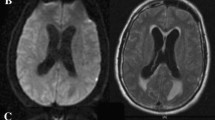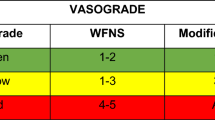Abstract
Background/Objective
Aneurysmal subarachnoid hemorrhage (aSAH) is associated with high morbidity and mortality despite advances in management. We evaluated the prognostic significance of a qualitative score using brain magnetic resonance imaging (MRI) features obtained early after aSAH.
Methods
Patients with aSAH were enrolled in a prospective observational cohort and underwent brain MRI during their acute hospitalization. MRIs were rated using a scoring system that considers the anatomical location of signal intensity changes on diffusion-weighted imaging (DWI) and fluid-attenuated inversion recovery (FLAIR) sequences. The relationship between MRI scores and functional outcome defined by modified Rankin scale (mRS) at 6 months was evaluated in uni- and multivariable models.
Results
The cohort included 45 aSAH patients (median World Federation of Neurologic Surgeons (IQR) 2 (1–4)) who underwent brain MRI a mean (SD) of 9.0 ± 8.0 days after aSAH. At 6 months after aSAH, 26 patients had achieved a favorable outcome (mRS ≤ 2) while 15 had an unfavorable outcome (mRS > 2). Deep gray nuclei (DGN) score (p = 0.016), cortex + DGN score (p = 0.015), FLAIR score (p = 0.016), DWI score (p = 0.0045), and overall score (p = 0.0081) were significantly lower in patients with favorable outcome compared to those with unfavorable outcome. However, MRI scores were not independent predictors of outcome in multivariable models adjusting for admission Hunt and Hess, Glasgow Coma Scale, or World Federation of Neurologic Surgeons scales.
Conclusions
In this pilot study, a qualitative scoring system using anatomically defined MRI FLAIR and DWI signal abnormalities identified in the acute phase of aSAH was linked to 6-month functional outcome. However, these scores did not add prognostic value to established indices of neurological severity.

Similar content being viewed by others
References
Zacharia BE, Hickman ZL, Grobelny BT, et al. Epidemiology of aneurysmal subarachnoid hemorrhage. Neurosurg Clin North Am. 2010;21:221–33.
Piran P, Nelson SE, Suarez JI. Prognostication in subarachnoid hemorrhage. In: Greer D, Dangayach N (eds) Neuroprognostication in critical care. Cambridge University Press (2020) (in press).
Rosengart AJ, Schultheiss KE, Tolentino J, Macdonald RL. Prognostic factors for outcome in patients with aneurysmal subarachnoid hemorrhage. Stroke. 2007;38:2315–21.
Pegoli M, Mandrekar J, Rabinstein AA, Lanzino G. Predictors of excellent functional outcome in aneurysmal subarachnoid hemorrhage. J Neurosurg. 2015;122:414–8.
Bitar R, Leung G, Perng R, et al. MR pulse sequences: what every radiologist wants to know but is afraid to ask. Radiographics. 2006;26:513–37.
Nelson SE, Sair HI, Stevens RD. Magnetic resonance imaging in aneurysmal subarachnoid hemorrhage: current evidence and future directions. Neurocrit Care. 2018;29:241–52.
Lövblad KO, Baird AE, Schlaug G, et al. Ischemic lesion volumes in acute stroke by diffusion-weighted magnetic resonance imaging correlate with clinical outcome. Ann Neurol. 1997;42:164–70.
Thijs VN, Lansberg MG, Beaulieu C, Marks MP, Moseley ME, Albers GW. Is early ischemic lesion volume on diffusion-weighted imaging an independent predictor of stroke outcome? A multivariable analysis. Stroke. 2000;31:2597–602.
Smith EE. Leukoaraiosis and stroke. Stroke. 2010;41:S139–43.
Wijman CAC, Mlynash M, Caulfield AF, et al. Prognostic value of brain diffusion- after weighted imaging cardiac arrest. Ann Neurol. 2009;65:394–402.
Hirsch KG, Mlynash M, Jansen S, et al. Prognostic value of a qualitative brain MRI scoring system after cardiac arrest. J Neuroimaging. 2015;25:430–7.
Sair HI, Hannawi Y, Li S, et al. Early functional connectome integrity and 1-year recovery in comatose survivors of cardiac arrest. Radiology. 2018;287:247–55.
Grote E, Hassler W. The critical first minutes after subarachnoid hemorrhage. Neurosurgery. 1988;22:654–61.
Friedrich V, Flores R, Muller A, Sehba FA. Luminal platelet aggregates in functional deficits in parenchymal vessels after subarachnoid hemorrhage. Brain Res. 2010;1354:179–87.
Janssen PM, Visser NA, Dorhout Mees SM, Klijn CJM, Algra A, Rinkel GJE. Comparison of telephone and face-to-face assessment of the modified Rankin Scale. Cerebrovasc Dis. 2010;29:137–9.
Savio K, della Pietra GL, Oddone E, Reggiani M, Leone MA. Reliability of the modified Rankin Scale applied by telephone. Neurol Int. 2013;5:6–7.
Connolly ES, Rabinstein AA, Carhuapoma JR, et al. Guidelines for the management of aneurysmal subarachnoid hemorrhage: A guideline for healthcare professionals from the American Heart Association/American Stroke Association. Stroke. 2012;43:1711–37.
Acknowledgements
We thank the patients and their families as well as the clinical staff who contributed to this study. Further, we acknowledge the valuable insights provided by Dr. Peter van Zijl (Chief, Neuroscience, Division of MR Research, Department of Radiology and Radiological Science).
Funding
Funding sources permitting performance of this work included grants from the Brain Aneurysm Foundation and from a Johns Hopkins Anesthesiology & Critical Care Medicine Stimulating and Advancing ACCM Research (StAAR) Award.
Author information
Authors and Affiliations
Contributions
SEN: Study design, data abstraction and analysis, critically revised manuscript. PP: Data abstraction, critically revised manuscript. JH and HIS: Study design, critically revised manuscript. AS: Data abstraction. CW: Critically revised manuscript. JIS: Study design, critically revised manuscript. RDS: Study design, data analysis, critically revised manuscript.
Corresponding author
Ethics declarations
Conflicts of interest
S.E.N. Brain Aneurysm Foundation grant, Johns Hopkins Anesthesiology & Critical Care Medicine Stimulating and Advancing ACCM Research (StAAR) Award, Springer Nature and Boston Scientific personal fees. P.P. no disclosures. J.H. no disclosures. A.S. no disclosures. C.W. no disclosures. H.I.S. no disclosures. J.I.S. PCORI, NINDS/NIH. R.D.S. NIH//NHBLI, Johns Hopkins Discovery Award, Johns Hopkins Anesthesiology & Critical Care Medicine Stimulating and Advancing ACCM Research (StAAR) Award.
Ethical Approval/Informed Consent
This work was carried out with approval from the Johns Hopkins Institutional Review Board under two different protocols, and as such written informed consent was required for some but not all patients.
Additional information
Publisher's Note
Springer Nature remains neutral with regard to jurisdictional claims in published maps and institutional affiliations.
Supplementary Information
Below is the link to the electronic supplementary material.
Rights and permissions
About this article
Cite this article
Nelson, S.E., Piran, P., Hua, J. et al. Prognostic Value of a Structural Brain MRI Score in the Acute Phase of Aneurysmal Subarachnoid Hemorrhage: A Pilot Study. Neurocrit Care 35, 501–505 (2021). https://doi.org/10.1007/s12028-021-01209-0
Received:
Accepted:
Published:
Issue Date:
DOI: https://doi.org/10.1007/s12028-021-01209-0




